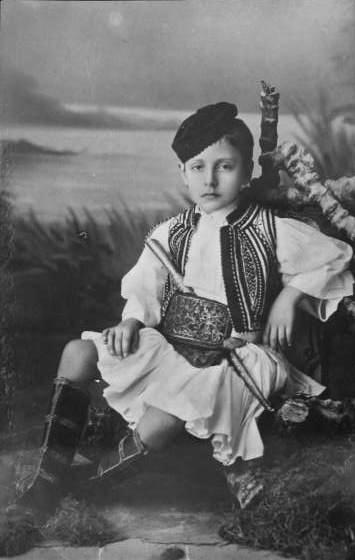
Figure 1.--Here we see a Greek boy around 1910 weariung a folk costume. This was a German post card series dating to about 1910 showing ethnic costumes throughout Europe. Notice the long sward. |

|
A kilt like costume was worn mainly in the central and southern regions of Greece. The costume derives its name from the pleated white skirt (foustanela) made of many triangular shaped pieces of cloth sewn together diagonally. The foustanela was worn by the Greek fighters of the 1821 revolution and today it serves as the official uniform of the Evzones, Greece’s Presidential Guard, who can be seen guarding the Tomb of the Unknown Soldier in Athens. The foustanela skirt consists of 400 pleats symbolizing the years during which Greece was under Ottoman rule. The remainder of the costume is composed of a white shirt with very wide flowing sleeves, an embroidered woolen vest, a sash worn around the waist, and shoes (tsarouhia) with large pompons.
There are two types of traditional clothing for men. On the mainland men wear a foustanela (kilt/skirt). A type of baggy trousers called a vraka is worn on the Aegean Islandsand Crete. The traditional Grecian costumes are the male's "foustanela" and the female's "amalia." They are beautifully handmade embellished with detailed needlework. The costumes consist of whiteblouses, vests, skirts, and even special shoes. Most Greeks now wear Western clothing. Even in rural areas Western clothing is now worn. People do sometimes wear traditioinal clothing for spoecial events.
The costume called Foustanela, established by Otto, the first King of Greece, as the formal in the middle of the 19th century, prevailed in the urban centers of Moreas (Peloponnese)and Roumeli (Central Greece). This dress was originally the military outfit of the Greek chieftains. The costume was soon modified by the men for holidays and other festive occasions. The outfi tthat is shown here has two jackets, the inner waist coat, the yileki, and a second sleeved shortjacket, the fenneli, with the sleeves falling freely over the back. The material that was used for this version. is wool. The embroidery is made of spun wool andthe belt is of a fine leather work.
The Foustanela has changed in the meaning of detailed work, the length of the fousta, and,sometimes, the number of jackets worn. The sleeves have become decorative, resembling wingswithout the function of sleeves. After all the changes, it has become the standard Pan-Hellenicmale costume used to the modern times.
After the liberation of Greece in the first quarter of the 19th century, all male costumes in the Peloponnese took the form of the foustanela. Extremely popular, this costume is now one of the world's most well-known traditional outfit:
Navigate the Boys' Historical Clothing Web Site:
[Introduction]
[Activities]
[Biographies]
[Chronology]
[Clothing styles]
[Countries]
[Bibliographies]
[Contributions]
[FAQs]
[Glossaries]
[Images]
[Links]
[Registration]
[Tools]
[Boys' Clothing Home]
Navigate the Boys' Historical Clothing ethnic pages:
[Return to the Main Greek ethnic costume page]
[Return to the Main Greek page]
[Return to the Main ethnic page]
[German]
[Irish]
[Native American]
[Scottish]
Navigate the Boys' Historical Clothing kilt pages:
[Return to the Main kilt page]
[Return to the Main national kilt page]
[Kilt suits]
[Scottish boys clothing]
[Scottish school uniform]
[Highland dance]
[Irish kilts]
[Irish boys clothing]
[Irish step dancing]
[Greek kilts]
